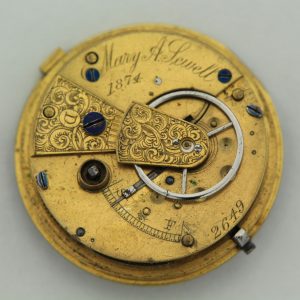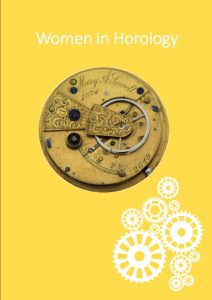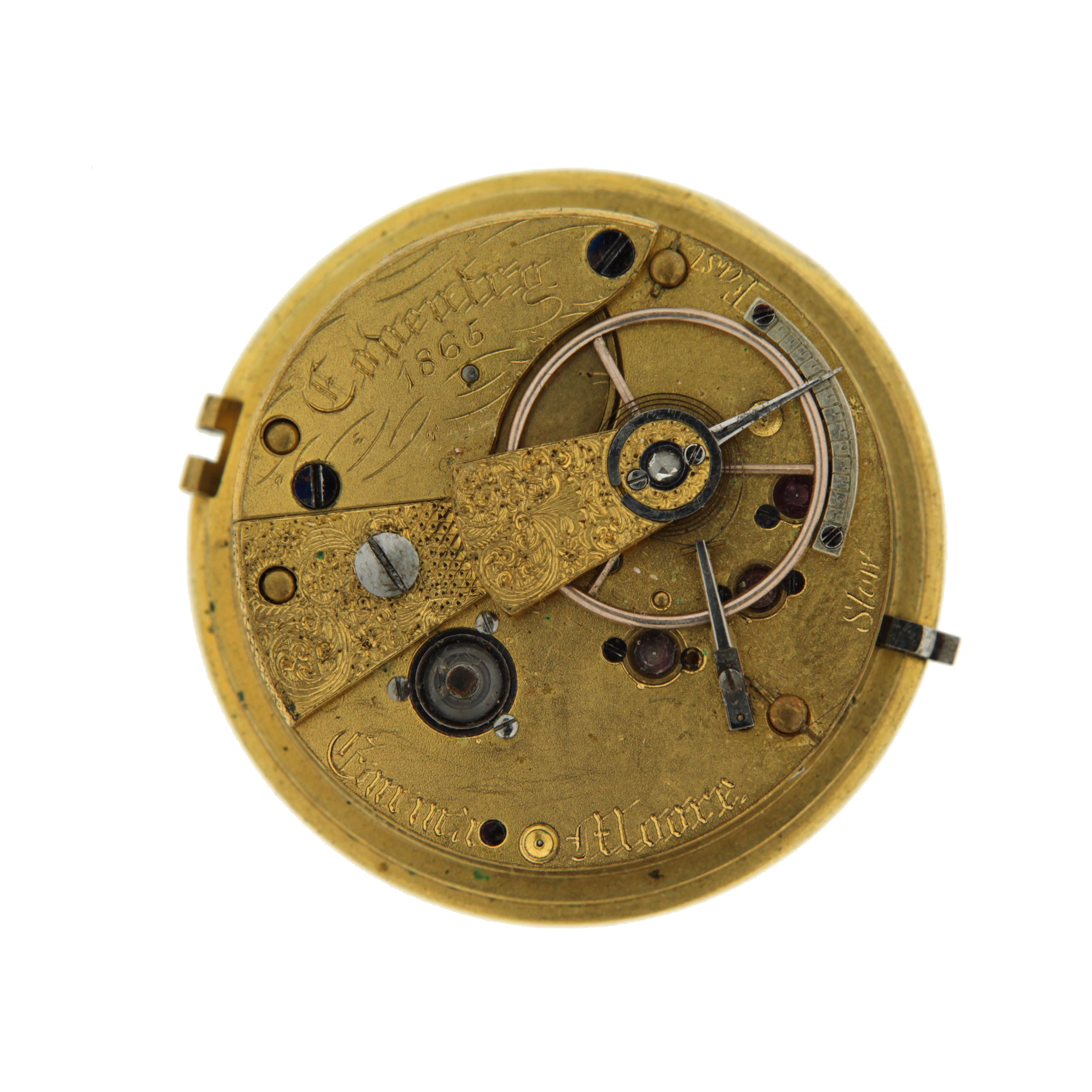5 May 2020 – Update
Highlighting Mary project – Women and Horology
There have been exciting developments with the Women and Horology Project.
Following the presentation of our lecture to the London section of the Antiquarian Horological Society in September 2019, it was decided that the project was of merit to both women’s history and our knowledge of an important subject within horology. Therefore it was agreed that the project would be transferred to the resources section of the Antiquarian Horological Society website where it could be seen by both researchers, general interest groups and those who might have further information, relevant to the work.
All new findings and the spreadsheet recording the lists of named women involved in horological businesses from 17th Century to 20th Century will be regularly updated there – see link below. The version posted on this website is the original one and will not be updated.
If you have any questions, information or wish to see what has so far been discovered about women working in horology please visit the site at
https://www.ahsoc.org/resources/women-and-horology
You can also email Su Fullwood using the dedicated email address of
Thank you for your interest in this long term ongoing project. We look forward to sharing our work with you and linking up with those also doing related research.
Sorry we have been a bit quiet for a fair while but it has been really very busy and very exciting.
Since I last posted we have put on two more exhibitions and a lot of work on our #HighlightingMary project. This culminated in a paper presented to the London branch of The Antiquarian Horological Society and will hopefully lead on to more collaborative projects and an information exchange about the subject of Women in Horology.
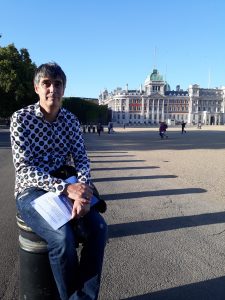 | 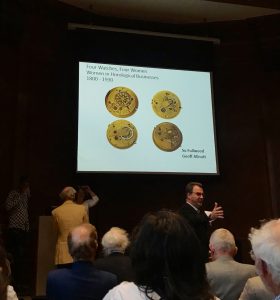 | 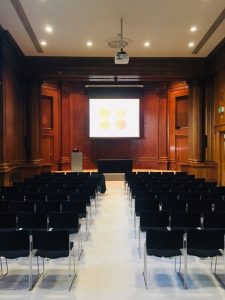 |
| Geoff Allnutt | Women in Horology Presentation |
As a reminder the #HighlightingMary project began when Geoff asked me to try and find how many women were listed as clockmakers or watchmakers in the various texts already published. He had acquired at that time four watches engraved with women’s names on the barrel bridges of the movement. The usual interpretation is that these names represent a commemorative or gifted watch or perhaps the first owner. However Geoff felt differently and thought they could be the maker’s name (or at least the person who retailed the watch).
I read books such as Loomes “Clock and Watchmakers of the World” cover to cover and noted all of the women listed as working with horologists. Most of these were women who took over the businesses after their husbands had died. Before 1882, married women couldn’t legally run businesses in their own names but they could do once they were widowed or if they were unmarried. We were very surprised at the numbers of women working in horological businesses but when we started searching the primary sources we found that it was just the tip of the iceberg. Intensive study has revealed many women working in the field and some of their personal individual stories. We also found two women working as clock and watchmakers in West Street where Geoff now runs his business. They were both called Mary and this is why we started the social media hashtag #HighlightingMary which has provided a banner for the work to date. The reason we have felt telling these hidden stories is important is because they have so often been lost to us down the years of history. To quote Dr Ailsa Holland, one of the three women who created the @onthisdayshe twitter account ““history has failed to see women as workers, to see beyond their traditional roles to their hands and their brains and so the memory of their achievements has been lost again and again”.
In the same way along with several other researchers we are seeking to change this and put women firmly into the centre of the history books, publications and exhibitions, celebrating their achievements whether they are world changing or part of everyday life.
We spent a fantastic evening with The Antiquarian Horological Society on 19th September 2019 and we were very grateful for their warmth, hospitality and above all their enthusiasm for this project. We are now discussing ways of making all the information available and collaborating with others to bring the many women involved in horology into the public awareness, along side those scientific, artistic and notorious individuals who have shaped our past, present and future but have very often been forgotten.
Do watch this space for more information on the #HighlightingMary project. Meanwhile go and see our small but neat display “A Shop In Time” exhibited in the social history gallery of The Novium Museum in Chichester. It tells some of the stories of the people who have lived and worked in the premises that now houses J E Allnutt and Son, Littlecogs and Geoff Allnutt Clocks. It represents over 200 years of clock and watchmaking in West Street, Midhurst. The Novium, situated in Tower Street, Chichester is an excellent regional museum with fantastic archaeological and social history collections. It is free to visit and is open throughout the week. We fully recommend a visit even without seeing our horological themed exhibition.
Su Fullwood
Click on the Watch below to view a comprehensive listing of women working in the field of horology during the 18th, 19th and 20th centuries.
All sections can be searched by putting in a keyword or part word into the search engine.
We have included women’s names, place of work and known “situation” or role in horology. Most of these have come from drawing on the exhaustive work of many others (listed below)
Under situation we have included different headings. The greatest majority of women are described as “widow” We have used this following Brian Loomes where we can’t say for certain what role the person had taken on. For example they may be a watch or case maker or they may be running the retail side. The only fact we have is that they were married to a clock or watch maker and they ”carried on the business after their husband’s death”. In what capacity, further research is needed.
Although we have included some women from other countries the majority are from United Kingdom. There were many women working in the Swiss watch trade of course but the nature of the work organisation means that very few are named.
Click on the booklet to download the document
Bench view 141 Early Female Clockmakers
We have pretty extensive collection of the names of early 17th, 18th and 19th century clock and watch makers, thanks to a few highly specialised researchers who have searched parish records, the company records and a myriad other primary sources to complete the various lists that are available. Readers will be aware that I rely often on Loomes (1). I feel however there are a significant group of workers in our trade that were obviously present but are broadly un represented in the literature. I refer of course to female clock and watchmakers.
I wonder if it is safe to assert that it is likely that clock and watch making in the early part of the 18th century was, outside London, to all intents and purposes a ‘cottage industry’ there were external suppliers of parts; dials, suites of movement parts and the manufacture of cases. However much of the assembly and making work was carried out in very small family groups, perhaps Father being the recognised clock / watch maker and his family being largely hidden from us. However, if we take a closer look at a this we might imagine, that in a small family group, the wife may well have made not just the major contribution to the home making but also a major contribution to the business. We have a few records of Widows taking over the clockmaking business on the death of the principal and employing journey men to work for her. I have little doubt that a clockmakers wife of a few years standing would be a very important part of the manufacture of clocks, and very likely have been perfectly capable of making or at least assembling a clock herself. Similarly I expect it would be highly likely that children would have been involved in the clock / watch making process. Even as young children, being given small jobs to do, firstly to keep them out of mischief and later as an important contributing part of the family economic unit. One only has to read contemporary reports, even contemporary fiction to see how important was the input of both male and female children to making the family economic unit viable. We are clearly aware of the contribution made by children and young people in the manufacture of Fusee chains for the clock and watch industry (2).
I am indebted to my friend to John Robey for sending me details (3) of Elizabeth Boot, born 1726 Elizabeth was trained in clockmaking by her father (John Boot of Sutton in Ashfield) along with her brothers John and William. Elizabeth produced 30 hour clocks with her name Eliz.th Boot Sutton on the dial. In 1760 at the age of 34 she married Richard Foxton of Chesterfield who was not as far as we know, a clockmaker. From this date forward there are no records of any further clocks made by Elizabeth. However, we know that Elizabeth trained her son James in the trade, James was born in 1764 and died 1835, clocks signed by him may be found from 1790 onward. There are two very interesting things we might surmise at this point; firstly Elizabeth retained her tools and obviously her ability to make clocks for perhaps over fifteen after marriage, as she was able to train her son in the craft. The second interesting factor, is that no further clocks were recorded as being made by her after marriage in 1760. We might ask ourselves why were there no clocks made by her recorded after her marriage.
I searched the internet seeking more information on female clockmakers of this period and was very pleased to find an article by Dr Amy Erickson (4) Dr Erickson has carried out some important research in to the records of various Worshipful Companies pertinent to the time, the results are interesting. We know that to trade in the City of London one had to be a member of a City Company. However, one did not have to be a member of a specific Company, we know that clocks were made by clockmakers who were members of a range of companies, perhaps blacksmiths being possibly the most numerous. For example a woman trading as Milliner could be , and was, a member of the Worshipful Company of Clockmakers (WCC) . Erickson cites Elinor Mosely born 1701 who was apprenticed to George Tyler a freeman of the WCC in 1718. There is a George Tyler listed in Loomes (5) as working in Popes Head Alley Lombard Street at about this time, if this is the same Tyler, he was himself apprenticed to Robert Dingley. Erickson reveals that while Elinor was apprenticed to George Tyler and was made free of the WCC in 1726/7 she was actually trained as a Miliner, possibly by Tyler’s wife Lucy. This throws some more dust in to the air, when we are trying to research female clockmakers of the time, sadly for us, those who are recorded as being members of the WCC did not automatically make clocks.
What Erickson also goes on to inform us is that under the English custom of Coverture all of a woman’s pre marriage moveable property, including her stock, her employees, her profits and her company membership became her husband’s on marriage. This Coverture may go some way to inform us as to why clocks made by Elizabeth Boot, an independent working clockmaker in her own right before her Marriage, working far outside London also disappears from records after her marriage. It might also help to explain the reason that Elizabeth refrained from marriage until she was thirty four, which for the time I suspect was quite late. I wonder if this later age reflected the fact that on her marriage she would give up a great deal of her independence to her husband, I should imagine that making the right choice of husband for a woman in her situation was very important.
I commend Dr Erickson’s article to readers of the HJ. In this bench view I have only cited a flavour of the article, which runs to over 33 pages with over 150 foot notes. There is plenty to keep a reader interested in the sociology of horology, for a long time.
It would be wrong when considering the women who contributed so much to horology, and who as one of my correspondents suggested tend remain in the historical background, to leave out the women who worked in the decorative side of the trade, the dial painters who worked in the Birmingham dial factories. Even more importantly we should never forget those poor radium girls, (6) who in the 20th century painted the luminous paint on watch dials, nearly all of whom suffered a terrible work related deaths.
(1) Loomes. Brian, Watchmakers and Clockmakers of the World
(2) Newman. Sue, The Christchurch Fusee Chain Gang 2010
(3) Mather. H H, Clock and watchmakers of Nottinghamshire 1979
(4) Clockmakers , Milliners and Mistresses : Women trading in the City of London companies 1700-1750 Dr Amy Erickson (internet article)
(5) Loomes. Brian, Watchmakers and Clockmakers of the World
(6) The Radium Girls U tube video
Since posting our last piece on Women associated with horology, we had another signed watch movement brought to our attention. At first glance it looks very much like the name is Emma Moore.
However this is debatable and we are posting a photograph of the watch to see if any readers have further ideas as to what the engraving actually says.
It is possible it says Emmil or perhaps Emm’a (an abbreviation of Emmanuel)
So far we haven’t managed to track down an Emma Moore, watchmaker, but this doesn’t mean she didn’t exist. We are still working towards trying to ascertain whether the names on these four watches are the names of the makers. However we do believe the answer is out there.
Once again we would like to thank people who have been incredibly helpful with this work.
Seth Kennedy (Antiquarian Horologist, London) Seth saw this recent example and very kindly brought it to our attention. He has also been very supportive in looking out for further possible evidence. We are very grateful for his help and interest.
Sir George White, Curator of the Clockmakers Museum (at The Science Museum) We are very grateful indeed for Sir George’s time, patience and generosity. He is extremely knowledgeable on this subject and has been encouraging with research on our two local Women in Horology.
Also in addition to those in the acknowledgments for our October 2017 exhibition, we would like to thank the following. This is for their continuing support, advice and interest in respect of the work we are doing on clockmakers and women in horology locally
Dr Mike Flannery, Horological Conservator
Dr Rebecca Struthers,
Staff and students at West Dean College of Arts and Conservation
James Nye, Chairman of the AHS
Heritage Crafts Association
Lucy Herbert, Clock and Watch Restorer
Staff at Portsmouth City Records Office
A Search for Mary
It all started a few years ago with a watch, one inscribed with a woman’s name.
Geoff had come across it in a sale and bought it. Having never seen a watch with a female signature, he looked out for more and found others, two of which he obtained for the collection. So now he had three watch movements which were engraved with names of women on the movement.
Lizzie Sproxton, Uplands 1865
Mary A Sewell, 1874
Martha Nason, Stratford 1838
His interest was piqued. Geoff spoke to others in the profession and their suggestions ranged from the name representing the movement maker, the retailer or the owner, to the commemoration of a significant event such as a birthday.
Geoff felt it was most likely to be the first suggestion (movement maker or retailer) rather than the last option (owner or commemorating an event). The reasons being that it is unusual to engrave something commemorative in a place it will rarely be seen and that traditionally if a movement rather than the case is to be engraved, it is with the maker’s or retailer’s name.
This is where I came in. Employed by Geoff to organise and research various aspects of local history and the horology collection, we first tried to find references to the three women. We searched several databases and lists but unsuccessfully. We did find references to other clocks and watches signed with women’s names. The British Horological Institute Museum has a clock signed on the dial by Ann Piggott of Nottingham (a well known clockmaking family) and there are others in both private and public collections, but they still seem to be a rarity. At least women working in horology is perceived to be so.
As a result, Geoff challenged me to make a complete a list as possible of women who were related to horology in some way, from watch and clockmakers, to dial painters and case makers. This was something he had started to do when he first found the watches but had been unable to finish because of other commitments.
Lists of horologists have been made before: Britten, G. H. Baillie and then Brian Loomes’s continuation of this work, “Watch and Clockmakers of the World”. These are all meticulously researched lists and sit alongside many localised publications with further evidence. This includes Allen White’s work on the fusee chain makers of Christchurch, an 18th Century business that consistently employed women and children from poor houses, sadly because they came at a much cheaper rate than able bodied men (It is an important story and well worth the read). There are other lists on the internet too. My aim was to just collate them all under the heading “Women in Business”, so in the main I was using secondary sources. However, as I looked through these as well as documents, such as “The Register of Apprentices in The Company of Clockmakers”, it is clear that women in horology practising a related craft during the 18th and 19th Centuries was certainly not a rare phenomenon. This is no particular surprise to me following many years researching women’s history, but what is evident is that, as in every other period, these business people, crafts people and entrepreneurs are in the main hidden in history with little written about them. Certainly in the generalised history books on horology, interesting as they are, women rarely get a mention, despite there being several recorded in the various original documents available. However I do know that this is being rectified by those who have a greater knowledge and understanding of the period and craft. Soon some of those hidden stories will become more widely known.
On a more personal note however, for us here at Allnutts, we were also simultaneously researching local clock and watchmakers for an exhibition at The Midhurst Museum (which had a successful run during October 2017). We had been particularly interested in those who occupied Geoff’s current premises in West Street over the centuries. He now employs 3 other watch makers and a clockmaker in a thriving business, continued from his dad’s time here (There is more about our findings under the research/exhibition section).
While scrolling through the published lists and books, I came across many women throughout the country who were involved in the business of horology in some way or another. The most exciting find being that two of the previous occupants of West Street were women who both strongly emphasised their roles as watchmakers, as well as being heads of the household and business. Mary Wrapson had been married to Charles Wrapson, a Clockmaker and watchmaker, but continued on after he died. Mary Ann Lawrence was possibly a relation, who seems to have learnt the craft and she took over the watchmaking business approximately 30 years later when Mary’s son and heir died childless.
I do need to emphasise that by watch and clock making I am referring to retailers who put their names to the movements they sold. These men and women may have been trained in the business but they would have been unlikely to have ever made a watch or clock from scratch themselves. They did however have a great technical knowledge which meant that they could maintain, repair and service the clocks and watches they sold. A great insight into such a business can be found in the autobiography of Edmund Howard who was a clockmaker in London in the 18th Century, running a business in which all of his family were involved to ensure its success and viability.
“My wife also was not a whit behind in diligence and close attention to business, both in her household affairs, distilling simple waters, and often helping me both in the shop and the garden, and my children, as soon as able, helped in any works their strength could manage; one of my daughters, when very young, learned to clean an eight-day clock, and in a little time could do it as well as myself, and could put it together when cleaned”.
Edmund Howard (1710–1798): A Quaker Clockmaker in Chelsea
An article about Edmund Howard, written by Dr James Nye, can be found in the December 2017 issue of Antiquarian Horology and links to the transcription of the autobiography on the Antiquarian Horological Society website : ahsoc.org/publications/the-journal
We are now in the exciting process of studying original documents to find out more about our two local watchmakers for another exhibition next August (2018).
In the meantime, we are posting the collated list here in the hope it may be of some help for anyone researching related subjects. It may at least give an initial, general background picture. It is very unlikely to be complete. New information appears all the time and we will continue to add to it as and when more references, or clocks and watches surface. There will also be many wrongly included names of women who are in the records but were associated with the people but not the craft. However this is why further work on this subject is so important, looking at individuals and their contribution to the craft and profession as a whole to get a more detailed view.
Our next step will be to concentrate in more detail on our local makers. As with all our work we welcome comments or further information which could be included, to enable us to get a better, fuller picture.
Although it started with three watches (and we are still to find out who the names refer to) it became a much wider story.
In turn this led us back to two Marys, Watchmakers in West Street, Midhurst (possibly at St Johns). A personal and important discovery.
More to follow
Main Sources and References
Loomes B – Clock and Watchmakers of The World 3rd Edition
- H. Baillie – Watchmakers and Clockmakers of the World
Britten – Britten’s Old clocks and Watches and their Makers
The Clockmaker’s Company, Register of Apprentices 1631 – 1931
We are indebted to this list found at this American site. However I have been unable to find the author’s name but I am continuing to try.
http://homepages.sover.net/~donnl/Women/women.html
I also advocate the words of this author who has said very eloquently
“The compilation of this directory, by default, relies extensively on those lists published by other writers and compilers in the field. While the authority of any list compiled from secondary sources is always suspect, I feel it would be counter-productive in terms of time and effort to repeat the original research done by so many others, whether in this country, in Canada, or in Europe. I am unfortunately well aware that some of those original lists contain errors. In an attempt to reduce these errors to a minimum, every list available (See the Bibliography) has been reviewed, appropriate names extracted, a sub-list compiled from each list, and this sub-list then merged into the master listing. In this manner, it has been possible to discover that a name assumed to be that of a woman has been identified in another list as a male, or that someone who was ‘apprenticed’, in all truth had actually been employed as a maid or as a servant”
While compiling our list I have included some of the names previously left out from the above compilation until those women can categorically be proven not to be working in the horological field. As this becomes more apparent I will annotate the list so that it is recorded that the names have been checked. If other people have information that can exclude any of the names on this list we would be grateful to hear.
For further references used to compile original lists see this list from Clockmakers Company Website (www.clockmakers.org/horology/horological-bibliography)
Additionally
Abbott Henry G – An Encyclopedia for the Horologist, Jeweler, Gold and Silversmith
Tardy – Dictionary of French Clockmakers

